Artists’ Residency in Colombia
Forest Utopias
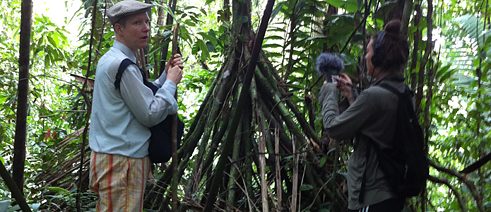
During their Forest Utopias residency in the rainforest of Colombia’s Departamento del Chocó, participants deal artistically with the region and its inhabitants. Here, we present the work of some of the resident artists.
The Forest Utopias artists’ residency of the Goethe-Institut Colombia offers space to reflect on social and environmental issues in Latin America. Since 2015, artists have been able to come into contact with the people of Chocó and focus on the flora and fauna of the rainforest by the Pacific.
There are two residency places each year. One of them is granted by the Goethe-Institut Colombia, for example this year to Apichatpong Weerasethakul for the project Experimenta/Sur.
The second residency is decided by the foundation Más Arte Más Acción and the Goethe-Institut following a nomination procedure by experts or by a public call for applications. The candidates must either be German nationals or live in Germany and have a declared interest in a stay in Chocó.
Residents are required to write an article for the MAMA Foundation yearbook or to produce a work of art. Examples of these are the installation “5qm” by Peter Rühle and the video work by Lia Rodrigues.
Peter Rühle
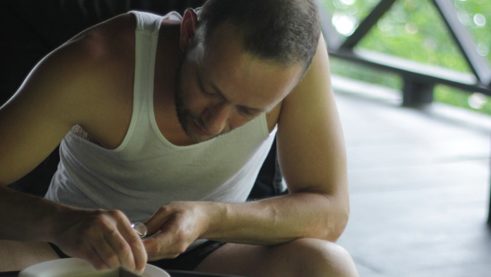 Peter Rühle.
| Photo: Andrés Vélez
Artist Peter Rühle travelled more than 10,000 kilometres from Berlin to Chocó where he is exploring the omnipresent colour green. The special relationship that the painter has with colours is reflected in his documentary works on the hues of green:
Peter Rühle.
| Photo: Andrés Vélez
Artist Peter Rühle travelled more than 10,000 kilometres from Berlin to Chocó where he is exploring the omnipresent colour green. The special relationship that the painter has with colours is reflected in his documentary works on the hues of green:"[…] No distinction, no construction, only documentation. A tiny five-square metre piece of primeval forest, an hour’s walk from the coast, provides more than enough material. In no time, over one hundred samples of different forms and hues of green are in the box. […]"
His stay in Chocó also urged him to reflect on the art world in Berlin, London, Kassel and New York:
"[…] Here, at the other end of the world where the rainforest and the ocean meet, the distance to the art world in which I usually move is huge both mentally and spatially, and the cigarette butts and flickering incandescent lamps hanging crookedly from their cables presented there seem, with their self-referentiality, all the more remote, almost ridiculous – as if Bourdieu had never written Distinction and as if the fairy tale of “The Emperor’s New Clothes” had nothing to do with it all. […]"
The works from Chocó were exhibited in Bogotá following the residency.
Robert Lippok
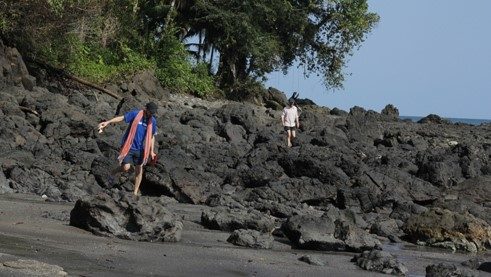 Peter Rühle and Robert Lippok.
| Photo: Andrés Vélez
“It is hard for me to express my stay in Chocó in words. Rarely have I been so afraid, alone in my house at night, a hundred metres from the beach, on the edge of the rainforest. But also rarely has the beauty of nature revealed itself to me with such force. On the day of my departure I was bewildered, broken up, speechless.
Peter Rühle and Robert Lippok.
| Photo: Andrés Vélez
“It is hard for me to express my stay in Chocó in words. Rarely have I been so afraid, alone in my house at night, a hundred metres from the beach, on the edge of the rainforest. But also rarely has the beauty of nature revealed itself to me with such force. On the day of my departure I was bewildered, broken up, speechless.It was a blessing that Ana Garzón Sabogal from Más Arte Más Acción accompanied my journey. I had so many questions: about the political situation, the climate change that is perceivable in Chocó, the situation of the indigenous peoples... She was able to answer many of them, or she introduced me to someone who could.
My time there was brief and intense. To this day, it feels as though a part of me is still there, at night, looking at the Pacific, thunderstorms in the distance.”
Robert Lippok works as a musician and visual artist.
Lia Rodrigues
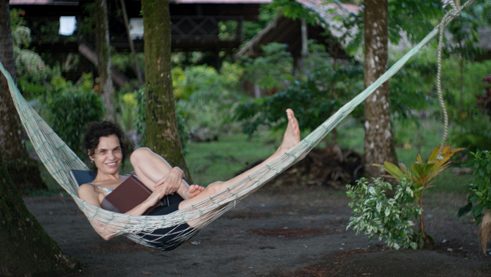 Lia Rodrigues.
| Photo: Andrés Vélez
Choreographer Lia Rodrigues sought out dialogue between the villagers in Chocó and in Favela da Maré. While the rainforest in Departamento del Chocó makes up half of the original forest of Colombia, the Brazilian favela lacks green spaces and trees. Grey Maré, green Chocó: the choreographer is positioning her artistic creation, a new piece for her dance company, between these opposites.
Lia Rodrigues.
| Photo: Andrés Vélez
Choreographer Lia Rodrigues sought out dialogue between the villagers in Chocó and in Favela da Maré. While the rainforest in Departamento del Chocó makes up half of the original forest of Colombia, the Brazilian favela lacks green spaces and trees. Grey Maré, green Chocó: the choreographer is positioning her artistic creation, a new piece for her dance company, between these opposites.
Carola Caggiano and Antonia Baehr
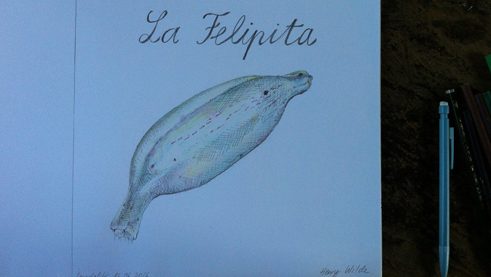 Drawing of the Felipita banana variety by Antonia Baehr.
| Photo: Andrés Vélez
We all know “global bananas.” You see them in any European supermarket. But in Guachalito, Chocó, where the jungle flows into the Pacific, different varieties grow, like Primitivo, Felipita or Mambule. Besides fish, these bananas are the staple food there and play an important role for the identity and culture of the region. The artists Antonia Baehr and Carola Caggiano want to return the banana’s multiplicity back to it. They made their drawings with pens and other things found in their hut in Chocó.
Drawing of the Felipita banana variety by Antonia Baehr.
| Photo: Andrés Vélez
We all know “global bananas.” You see them in any European supermarket. But in Guachalito, Chocó, where the jungle flows into the Pacific, different varieties grow, like Primitivo, Felipita or Mambule. Besides fish, these bananas are the staple food there and play an important role for the identity and culture of the region. The artists Antonia Baehr and Carola Caggiano want to return the banana’s multiplicity back to it. They made their drawings with pens and other things found in their hut in Chocó.
Sebastian Meschenmoser
The most poisonous frog in the world, the golden poison frog, is native to Chocó. The visual artist Sebastian Meschenmoser came across this amphibian in the forest. When he took the boat to the village of Coquí to give the schoolchildren drawing lessons, he also saw whales and dolphins. During his residency, Meschenmoser was particularly impressed by the strong influence of nature on his everyday life: the weather played a major part in daily planning and the extreme humidity softened the paper and made drawing difficult. So instead, he photographed a great deal and collected the inhabitants’ stories. Today he says, “Once you’ve been there for awhile, you begin to believe even the strangest anecdotes.”
Sebastian Meschenmoser’s stay was organised by the library of the Goethe-Institut Colombia.
Apichatpong Weerasethakul
 Apichatpong Weerasethakul.
| Photo: Andrés Vélez
The Thai filmmaker Apichatpong Weerasethakul used the artists’ residency as a starting point for photo studies in Colombia. He focused on the diverse ways that art and science interconnect. Using colour as a technical basis, Weerasethakul devoted himself to gathering, documenting and archiving his research. His collected impressions from Chocó and other parts of Colombia form the starting point for his next film.
Apichatpong Weerasethakul.
| Photo: Andrés Vélez
The Thai filmmaker Apichatpong Weerasethakul used the artists’ residency as a starting point for photo studies in Colombia. He focused on the diverse ways that art and science interconnect. Using colour as a technical basis, Weerasethakul devoted himself to gathering, documenting and archiving his research. His collected impressions from Chocó and other parts of Colombia form the starting point for his next film.
Regina de Miguel
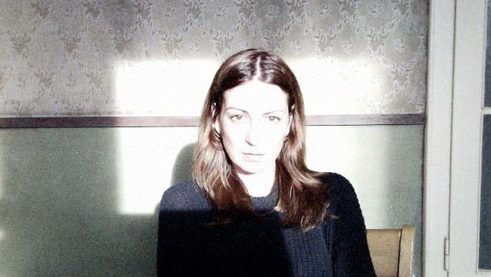 Regina de Miguel.
| Photo: Regina de Miguel
“I am beginning to love the abyss from which I am made.
Regina de Miguel.
| Photo: Regina de Miguel
“I am beginning to love the abyss from which I am made.The aim of this project is to realise an audio-visual experiment meant to penetrate the psychological reality of the territory.
The Chocó setting shows us how relations with the earth can be understood as social relations of labour and exploitation. This is reminiscent of the characteristics of industrial capitalism of the nineteenth century and at the same time of the digital capitalism of the twenty-first century – an age of geopolitics that is governed by the search for energy and material resources for the production of communication devices.”
Regina de Miguel is the present resident artist in Chocó. The Berlin-based Spanish artist is planning to then hold a screening in Bogotá at Jardín 82 of the Goethe-Institut Colombia.